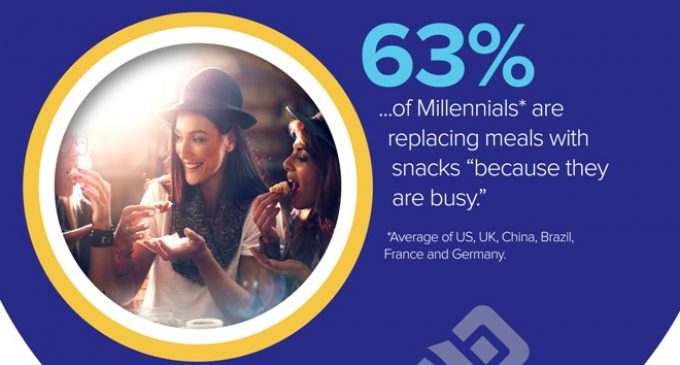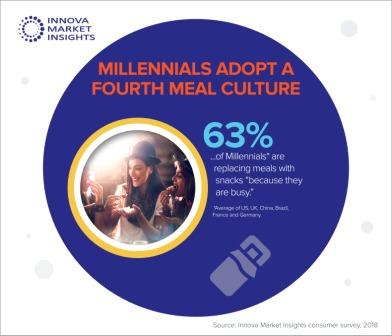Millenials Adopt a Fouth Meal Culture

There has been a 14% average annual growth in food and beverage launches with a snacking claim (Global, CAGR 2014- 2018), according to Innova Market Insights. For most consumers, snacking is a part of daily life and always has been. What is changing is the way people think about snacking and what is considered to be a snack.
“Fundamental changes in eating patterns largely driven by increasingly busy lifestyles mean that the traditional pattern of three meals a day has been giving way over some years to a less formal eating pattern,” says Lu Ann Williams, Director of Innovation at Innova Market Insights. “This is shifting to a more fragmented and flexible eating style, encompassing multiple small meals or snacks, often eaten alone or on the go,” she adds.
 This rise in the so-called “fourth meal” culture has increased demand for quick and convenient yet healthy solutions for busy consumers. This is creating opportunities for wholesome, satisfying and sustaining snacks to fulfill the role of mini meals and play a more meaningful role in contributing to refueling and nutritional needs throughout the day.
This rise in the so-called “fourth meal” culture has increased demand for quick and convenient yet healthy solutions for busy consumers. This is creating opportunities for wholesome, satisfying and sustaining snacks to fulfill the role of mini meals and play a more meaningful role in contributing to refueling and nutritional needs throughout the day.
Healthy snacking choices are seeing the fastest growth rates for NPD overall, with nutritious options gaining ground. This is led by vegetable-based snacks, with an increasingly high profile for on-trend ingredients such as more unusual nuts, ancient grains, hummus, avocado, seaweed, hemp and baobab, for example. On the go and lighter options such as miniatures, bites and puffs are also increasingly in evidence, as is the search for the right balance between health and indulgence.
There are also regional differences in preferred snack types, with Innova Market Insights consumer research indicating that nuts & seeds, chocolate and yogurt/drinking yogurt are the top three choices in the US, for example, while chocolate leads from potato-based snacks and sweet biscuits/cookies in the UK.
“As traditional meal times and occasions disintegrate and people seek quick, convenient, yet healthy solutions for busy lifestyles,” Lu Ann Williams notes. “We are continuing to move away from the traditional three-meals-a-day norm,” she concludes.

































